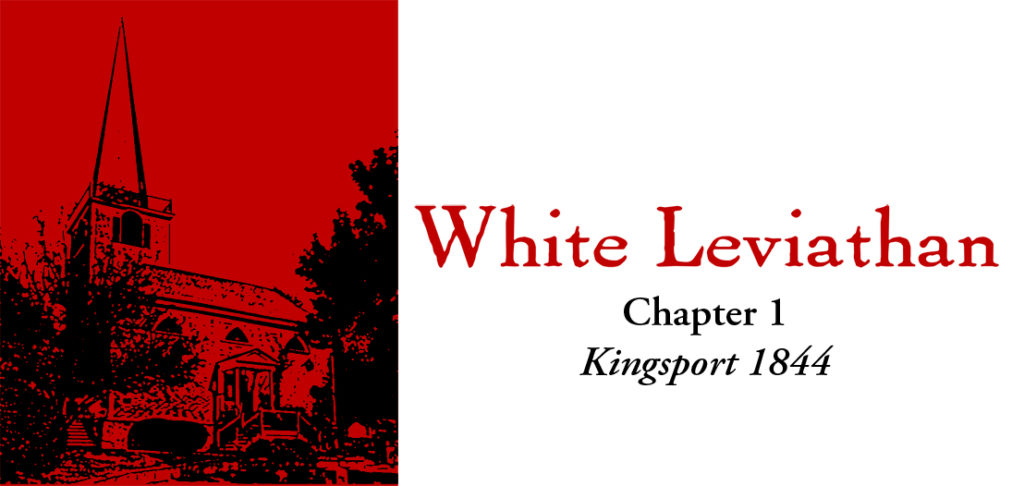Kingsport 1844: Harborside
- At August 22, 2019
- By Great Quail
- In Call of Cthulhu
 0
0
Harborside
The oldest neighborhood in Kingsport, Harborside stretches from the cliffs of Kingsport Head down to the harbor itself. As described in Kingsport, “Viewed from across the harbor, rows of houses can be seen stacked one upon the other, lining the narrow winding streets that follow the base of the cliffs. The rocky profile of Father Neptune juts out over the Illsley Shipyard. The shoreline of Harborside is uneven and rocky.”
Harborside is a large area, and is loosely divided into four districts. Inner Harbor begins at Hawthorne Street in the south and curves across Blake’s Creek all the way to Packet Street. The inner curve faces the water, and is roughly bound by a line running through Franklin and Ship Streets, while the outer curve describes an arc passing through Turner, Harris, Summit, and King Streets. Inner Harbor is populated by commercial establishments dedicated to serving the maritime industry. It’s rustic and fishy, but generally civilized. The area directly bordering the harbor is called the Wharves, and contains all the piers, docks, and slips of the northern harbor. To the east, the Wharves blend into the Yards, so-named because they represent Kingsport’s “big three” shipyards, operated by the Pickering, Illsley, and Tuttle families. The remainder of Harborside located between Inner Harbor and the Yards is unofficially known as the Cauldron. A rough and lawless red light district, the Cauldron is the most dangerous place in Kingsport.
The Parting Glass
As most of Kingsport’s drinking establishments are in or around Harborside, a few words should be said about mid-nineteenth century libations. While commercial breweries and distilleries exist in 1844, many smaller taverns and public houses craft their own beverages. Rum is the most popular alcohol by far, so most drinks contain domestic rum, often sweetened with molasses, maple syrup, or honey. “Black-strap” is a concoction of molasses and rum. Increase the amount of rum and replace molasses with brown sugar and lime, and “grog” is the result, often flavored with nutmeg or cinnamon. Grog that’s more rum than water is called “rattle-skull” or “pop-skull.” One colonial-era concoction still imbibed in Kingsport is “flip,” a mixture of rum, beer, molasses, and eggs. This is whipped to a froth, then scalded with an iron poker and decanted. (An iron poker is known as a “flip-dog.”) Along with wine, there’s hard cider and “shrubs,” mildly alcoholic drinks produced from berries or fruits fermented with vinegar. Homebrewed beers are common, made from grain and hops with plenty of flavorful additives, usually the ubiquitous molasses. Once variant of molasses beer is spruce beer, which contains molasses, spruce, sassafras, ginger, and allspice. Drinkers in the mood for something more exotic may have “sangaree,” which is Madeira or port wine flavored with molasses, lemon, and nutmeg. It’s considerably more heady than the sangria it would eventually become. However, New England’s most popular beverage remains “switchel.” In its non-alcoholic form, switchel is a refreshing mixture of water, vinegar, and—you guessed it—molasses, usually flavored with ginger. Add some rum, and you have something worthy of a sailor to drink!
I. Inner Harbor Locations & Encounters:
1. The Sign of the Knotted Iron
2. Kingsport Hotel
3. Mariner’s Bethel
4. St. Erasmus’ Home for Mariners
White Leviathan, Chapter 1—Kingsport 1844
[Back to Kingsport Encounters |White Leviathan TOC | Forward to Encounter 1, The Knotted Iron]
Author: A. Buell Ruch
Last Modified: 5 October 2021
Email: quail (at) shipwrecklibrary (dot) com
White Leviathan PDF: [TBD]

